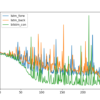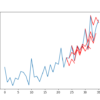Recurrent neural networks are able to learn the temporal dependence across multiple timesteps in sequence prediction problems. Modern recurrent neural networks like the Long Short-Term Memory, or LSTM, network are trained with a variation of the Backpropagation algorithm called Backpropagation Through Time. This algorithm has been modified further for efficiency on sequence prediction problems with […]










